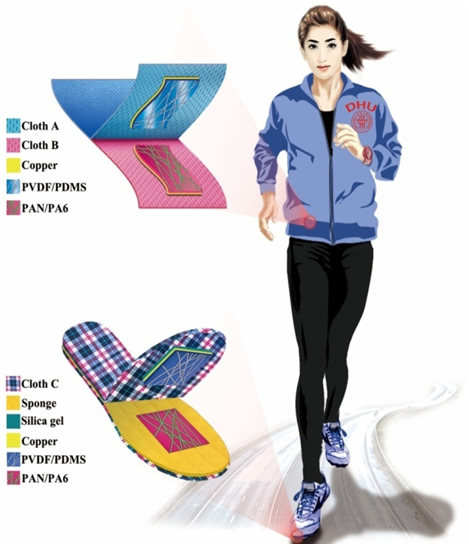Recently, Associate Prof. Zhaoling Li in College of Textiles has made a breakthrough progress in the area of flexible triboelectric nanogenerator for powering wearable electronics. The relevant research result was published in the world-famousprestigiousacademic journal Nano Energy(Nano Energy,2017, 36, 341-348. IF=11.55) in the title of “Nanofibrous membrane constructed wearable triboelectric nanogenerator for high performance biomechanical energy harvesting”. Donghua University is the only corresponding affiliation.

Demonstration of the flexible triboelectric nanogenerator to harvest various biomechanical energy.
In recent years, holding remarkable application potentials to bring revolution to our way of life, rapidly increasing research progress has been made in the field of wearable electronics. One critical challenge identified in this field is how to develop lightweight, flexible, sustainable and stable power sources, which are indispensable parts to power up the functioning devices in a wearable system.Reliance on the coupling effect of contact electrification and electrostatic induction, triboelectric nanogenerators have been proven to be a fundamentally new green energy technology for ambient mechanical energy harvesting, featured as being simple, reliable, costeffectiveas well as high efficiency.
In this work, Prof. Li and master student Jiali Shen presented a solution to power the wearable electronics by fabricating a nanofibrous membrane constructed wearable triboelectric nanogenerator (NM-TENG), using economically viable materials and scalable fabrication technologies. Electrospinng method was rationally introduced to prepare the triboelectric layers of NM-TENG. Under a gentle human hand tapping, the electric output of the NM-TENG can reach as high as110µA and 540V with an effective area of 16 cm2. And electric power was demonstrated to be delivered from wide range of biomechanical motions, such as hand tapping, body shaking, shoe insole from human walking and so on, which was capable of sustainably powering a commercial thermal meter, electronic watch, and lighting up about 560 LEDs.Given the combinatorial advantages of low-cost, excellent flexibility and mechanical durability, and remarkable scalability in the materials synthesis and device fabrication, the nanofibrous membrane constructed wearable triboelectric nanogenerator is not only a milestone work in the field of wearable electronics, but also renders a green and alternative to traditional methods potentially for large-scale energy generation.
This work is supported by the National Natural Science Foundation of China, the Fundamental Research Funds for the Central Universities, and the “DHU Distinguished Young Professor Program”.

